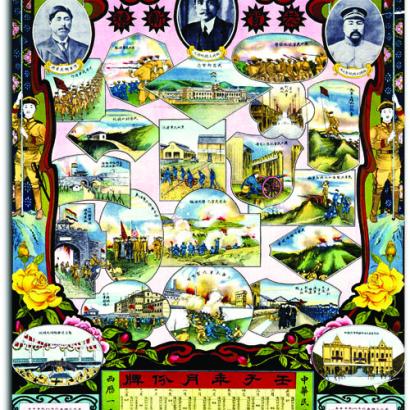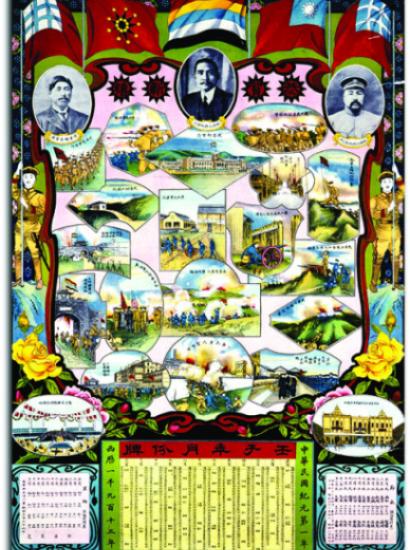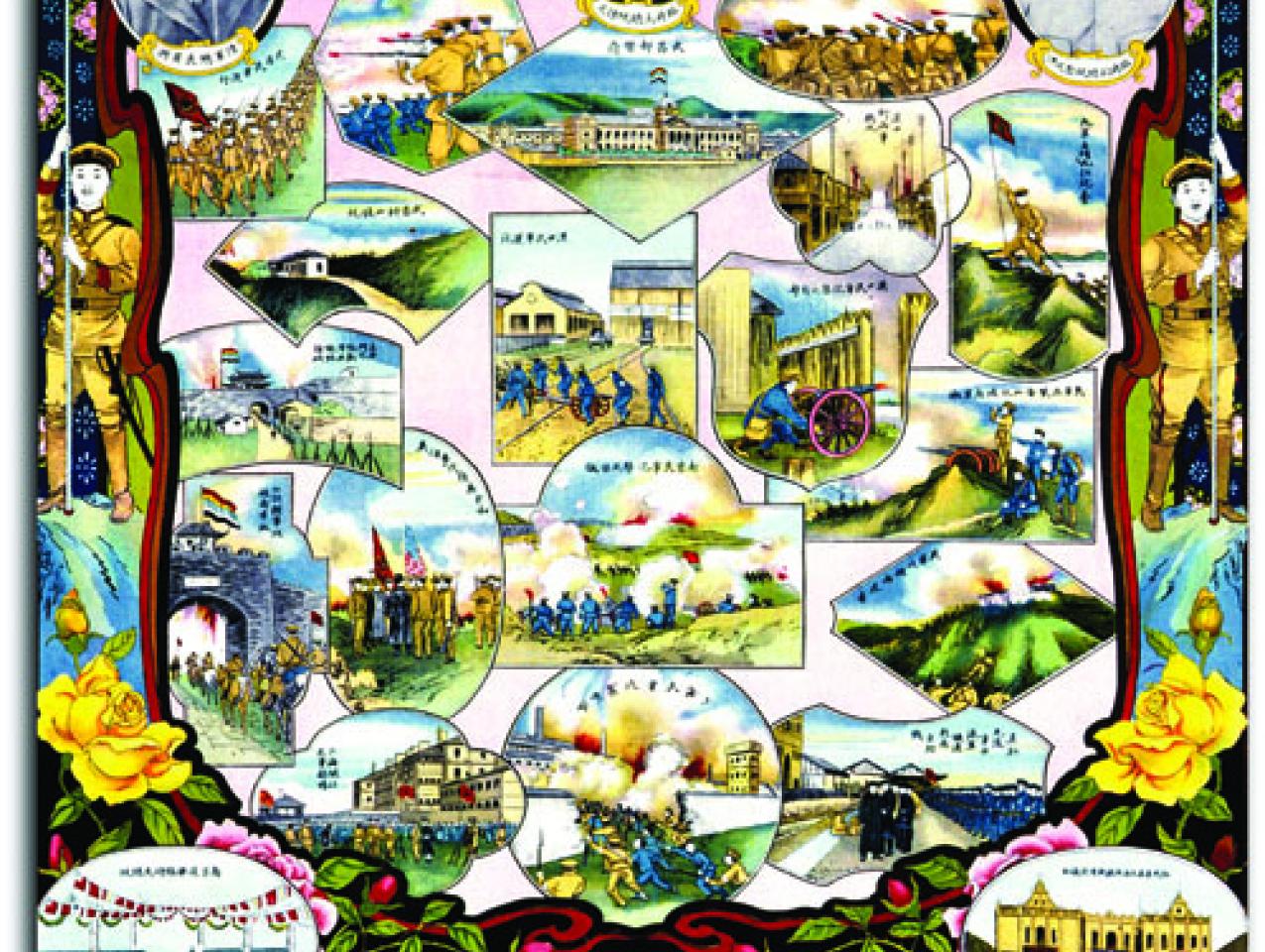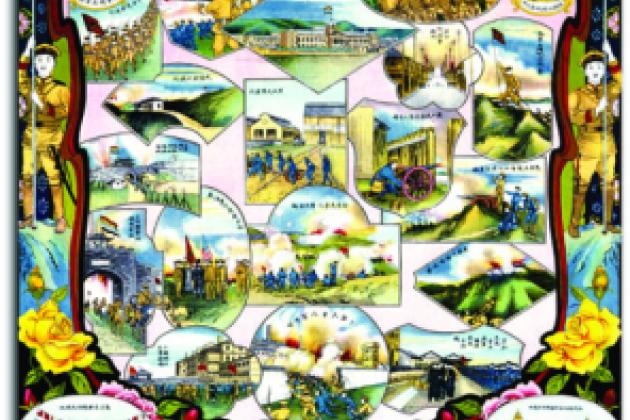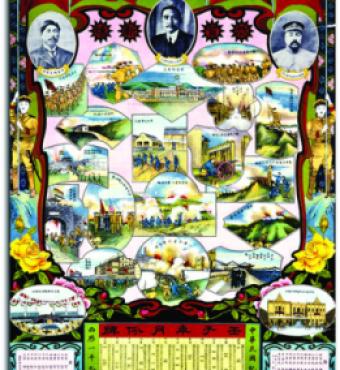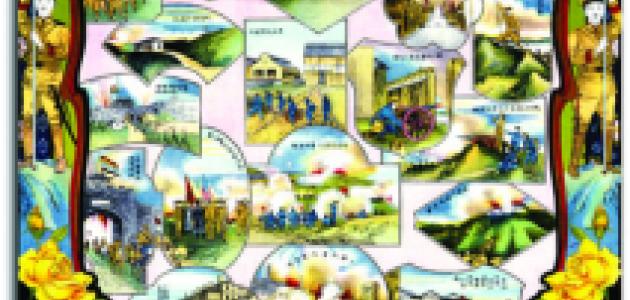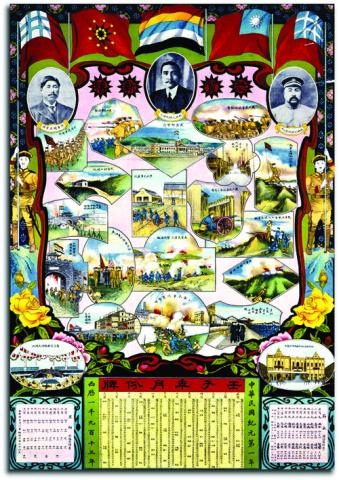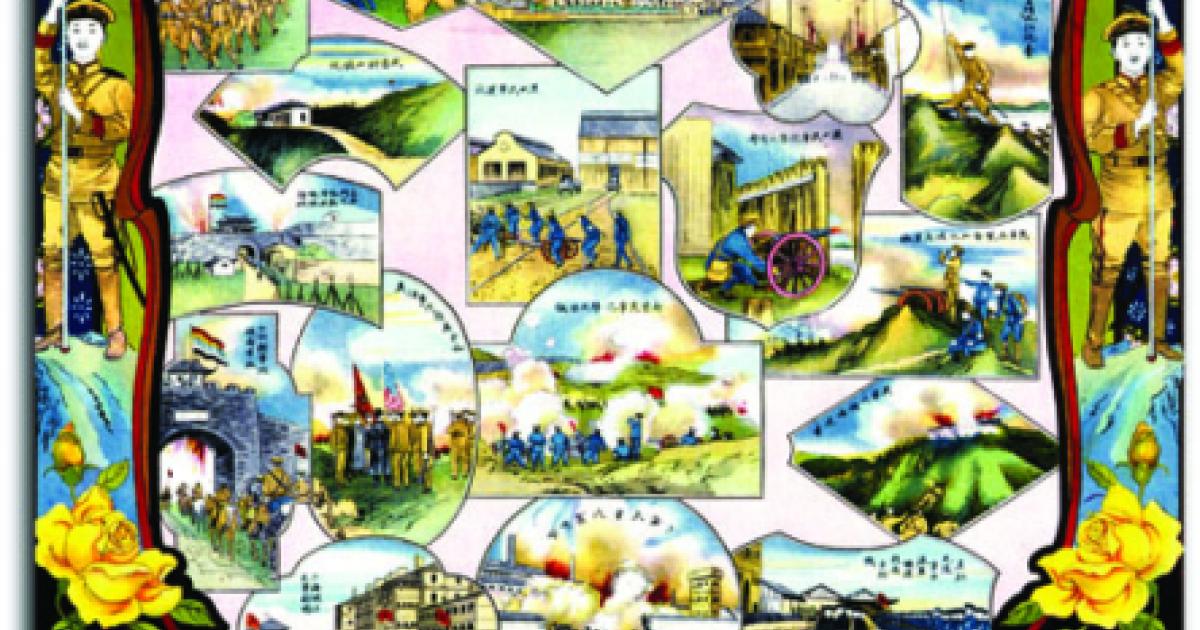This year marks the one hundredth anniversary of the Chinese Revolution of 1911, which swept away more than two thousand years of feudal monarchies and established Asia’s first republic, the Republic of China. The Xinhai Revolution, as it is known, was triggered by anger at corruption in the Qing imperial court, frustration with the government’s inability to restrain the interventions of foreign powers, and resentment by the majority Han Chinese toward a government dominated by the Manchu ethnic minority. It broke out on October 10, 1911, with an uprising in Wuchang, the capital city of Hubei Province along the Yangtze River. Within months, the revolution had succeeded in overthrowing 268 years of Manchu autocracy.
A new exhibit at the Hoover Institution, A Century of Change: China 1911–2011, draws on the rich holdings of the Hoover Library and Archives to offer a unique insight into the Xinhai Revolution, an episode that marked a significant turn in the convoluted course of Chinese modern history.
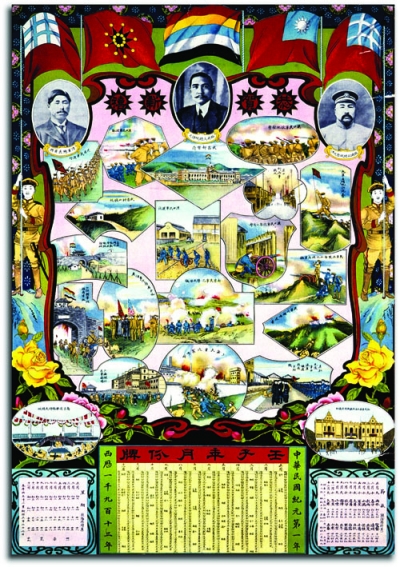 Sun Yat-sen, at top center of this 1912 calendar, was the catalyst for the overthrow of the Qing dynasty and was the Republic of China’s provisional first president. At left is Huang Xing, a fellow revolutionary; at right is Yuan Shikai, a military leader who later seized power and tried to re-establish the monarchy around himself. Battle scenes from the 1911 Wuchang uprising adorn the calendar. Across the top: flags signifying equal land distribution (far left, far right), the banner of the Wuchang revolutionaries (second from left), Sun Yatsen’s shining sun, later the Republic of China’s flag (second from right), and the republic’s original five-striped national flag (center).
Sun Yat-sen, at top center of this 1912 calendar, was the catalyst for the overthrow of the Qing dynasty and was the Republic of China’s provisional first president. At left is Huang Xing, a fellow revolutionary; at right is Yuan Shikai, a military leader who later seized power and tried to re-establish the monarchy around himself. Battle scenes from the 1911 Wuchang uprising adorn the calendar. Across the top: flags signifying equal land distribution (far left, far right), the banner of the Wuchang revolutionaries (second from left), Sun Yatsen’s shining sun, later the Republic of China’s flag (second from right), and the republic’s original five-striped national flag (center).
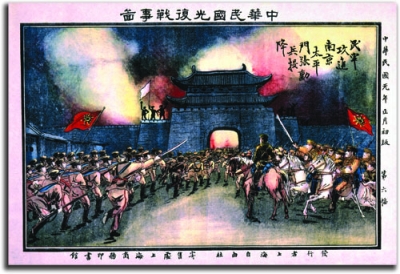 This image shows republican soldiers storming the Taiping Gate in Nanjing, one of the milestones of the Xinhai Revolution of 1911–12. This and other scenes of the revolution were commemorated in a series of prints by the Shanghai Commercial Press.
This image shows republican soldiers storming the Taiping Gate in Nanjing, one of the milestones of the Xinhai Revolution of 1911–12. This and other scenes of the revolution were commemorated in a series of prints by the Shanghai Commercial Press.
When the curtain opened on the twentieth century, China was still reeling from the Taiping Rebellion, the Opium Wars, and the first Sino-Japanese War of 1894–95. In 1900, the anti-foreigner Boxer Rebellion was led by the Yi He Quan (Righteous Harmonious Fists), who received orders from the Empress Dowager Cixi (1835–1908), the de facto ruler, to “protect the country and destroy the foreigners.” But an expeditionary column of twenty thousand troops from an eight-nation alliance of Austria-Hungary, France, Germany, Italy, Japan, Russia, the United Kingdom, and the United States quelled the violence. In September 1901, the Qing court signed the Boxer Protocol. China had to pay the bill—450 million taels, almost double the government’s annual income—and the eight nations wrested new concessions from the empire. When the Empress Dowager died in 1908 and Emperor Aisin Gioro Puyi, two years old, ascended to the throne, the Qing throne wobbled on the verge of collapse.
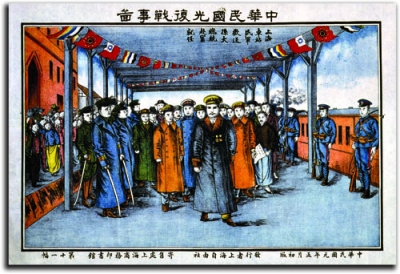 On January 1, 1912, Sun Yat-sen proclaimed the foundation of the Republic of China. This image shows him arriving at the Shanghai station to take a train to Nanjing, where the proclamation would take place. The last Qing emperor abdicated on February 12, ending 268 years of Manchu dynastic rule.
On January 1, 1912, Sun Yat-sen proclaimed the foundation of the Republic of China. This image shows him arriving at the Shanghai station to take a train to Nanjing, where the proclamation would take place. The last Qing emperor abdicated on February 12, ending 268 years of Manchu dynastic rule.
The man who would become known as the father of the republic, Sun Yat-sen (1866–1925), was the first to advocate the overthrow of the Qing dynasty and the establishment of a Chinese democratic republic. Sun was born to a peasant family in a village in southern Guangdong Province. At the age of thirteen Sun went to Honolulu, Hawaii, where his brother enrolled him in a missionary school. There he came under the influence of Western ideas of Christianity and democracy. Later, Sun studied medicine in Hong Kong. After graduation in 1892, he began practicing medicine in Guangzhou and Macao.
But Sun’s mind was soon preoccupied with the problem of curing the ills of feudal China. In 1894, he wrote a letter to Li Hongzhang, then the most powerful official in the imperial court, recommending reforms in agriculture, industry, commerce, and education. But Li turned a deaf ear to this unknown young man. China’s defeat by Japan in 1895 intensified Sun’s patriotic indignation. Convinced that saving the moribund regime through reform was a hopeless task, Sun decided that the Qing dynasty must be overthrown and the monarchy replaced by a free, enlightened China. He had become a revolutionary.
FROM SMALL BEGINNINGS
In 1894, with some twenty Chinese shopkeepers and farm owners in Honolulu, Sun formed the Xingzhong Hui (Revive China Society). The following spring he returned to Hong Kong with some followers and staged their first armed uprising against the Qing authorities in Guangzhou. It failed, but Sun began to be known at home and abroad as the leader of a revolutionary group.
After the failed 1895 uprising in Guangdong, Sun was declared a criminal with a price on his head. He fled to Japan and then traveled to the United States and Europe. Wherever he went, he worked to spread revolutionary ideas among the Chinese residents and students. In October 1896, Sun was kidnapped in London by Qing legation officials, who intended to return him to China for execution. Thanks to the aid of James Cantlie, former dean of the British medical college in Hong Kong where Sun had studied, he was rescued. This episode only strengthened Sun’s heroic image as a revolutionary leader, as well as his determination to topple the Qing court.
In the years that followed, Sun continued to travel around the globe, advocating revolution and soliciting financial and other forms of support for his cause. One important base was in Yokohama, Japan, where he, Huang Xing, and Song Jiaoren founded a new underground resistance movement, the Tongmeng Hui (United Alliance League), in 1905. Combining republican, nationalist, and socialist objectives, the Tongmeng Hui’s political platform was “Drive out the Tartars, revive China, establish a republic, and equalize land distribution.”
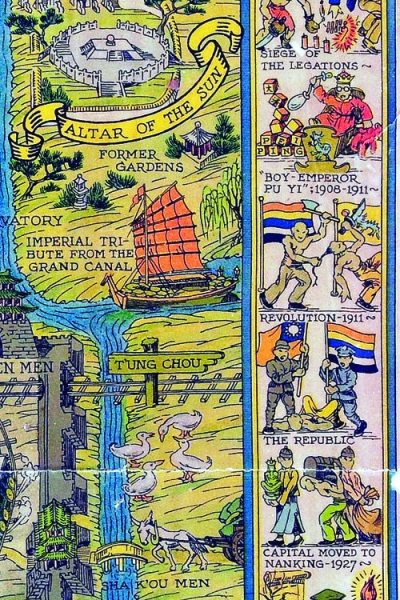 This closeup shows a whimsical map drawn by Frank Dorn (1901–81), an American artist and writer—later a brigadier general—attached to the staff of General Joseph Stilwell before and during World War II. Here Dorn depicts “the Boy Emperor,” the 1911 revolution, and the republic. The Stilwell and Dorn collections are both housed at Hoover.
This closeup shows a whimsical map drawn by Frank Dorn (1901–81), an American artist and writer—later a brigadier general—attached to the staff of General Joseph Stilwell before and during World War II. Here Dorn depicts “the Boy Emperor,” the 1911 revolution, and the republic. The Stilwell and Dorn collections are both housed at Hoover.
As discontent mounted all around China during the last decade of the nineteenth century, two opposing movements had sought to revive China: the revolutionaries and the reformers. The reformers, led by Kang Youwei and Liang Qichao, sought to change the status quo within the confines of the imperial system. Emperor Guangxu (1874–1908) believed that by learning from constitutional monarchies like Japan, China would become more powerful politically and economically. However, the reforms were viewed as too extreme for a China still heavily influenced by neo-Confucian statecraft. Displeased, Cixi saw these changes as a serious threat to her power and condemned the reforms as too radical. She placed Emperor Guangxu under house arrest. Kang and Liang escaped to Japan.
Nevertheless, the revolutionary upsurge forced a reluctant Qing court to eventually institute reforms to stave off its final collapse. After the Empress Dowager’s death in 1908, the Qing outlined steps to be taken during a nine-year period preparatory to establishing a constitutional monarchy. Though impressive, these reforms were viewed as too little, too late. The imperial court became more isolated than ever among a dissatisfied and rebellious population. In October 1911, the uprising in Wuchang broke out.
Sun Yat-sen himself played no direct part in the Wuchang uprising. He was traveling in the United States and found out about it from a newspaper. Sun had favored an uprising in his native Guangdong. His rival within the Tongmeng Hui, Huang Xing, had favored an uprising in central China and had been planning one for late October. The revolutionary leaders were thus caught off guard, leaving the mutineers without a leader.
At first, the revolt was considered merely the latest in a series of mutinies that had occurred in southern China. It was widely expected to be suppressed quickly, but ended up having much larger implications because the Qing court failed to respond quickly. This allowed provincial assemblies in many southern provinces to declare independence from the Qing court and declare allegiance to the rebellion.
As news of the success of the insurrection broke, men in urban areas were instructed to shear off their queues (pigtails, a mandated hairstyle for men that symbolized subservience to the Manchu authority). Within a month, representatives from the sixteen seceding provinces met and declared a Republic of China. In February 1912, the child emperor Aisin Gioro Puyi abdicated, and 268 years of Qing imperial rule came to an end.
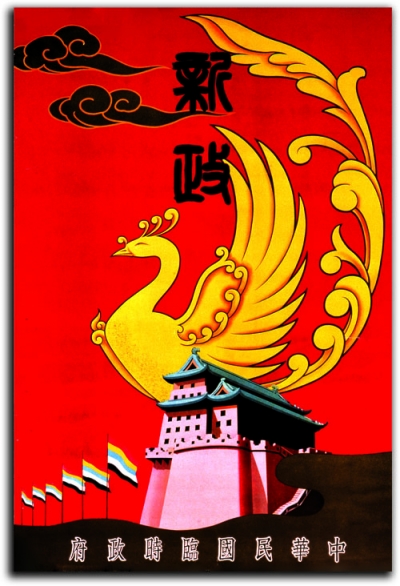 This propaganda poster draws on traditional Chinese imagery—a phoenix, the Forbidden City, the original republican flag—to promote a brief, Japanese-controlled collaborationist regime called the Provisional Government of the Republic of China. The puppet state was led by a Kuomintang turncoat named Wang Kemin and based in Beijing from 1937 to 1940. Wang was tried for treason after World War II and committed suicide in 1945.
This propaganda poster draws on traditional Chinese imagery—a phoenix, the Forbidden City, the original republican flag—to promote a brief, Japanese-controlled collaborationist regime called the Provisional Government of the Republic of China. The puppet state was led by a Kuomintang turncoat named Wang Kemin and based in Beijing from 1937 to 1940. Wang was tried for treason after World War II and committed suicide in 1945.
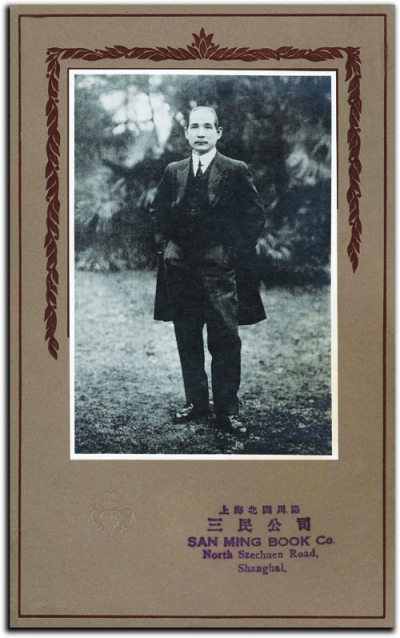 Sun Yat-sen, in a humorous exchange with his legal adviser Paul Myron Wentworth Linebarger (whose papers are among the Hoover collections), said of this photo: “Evidently, I was not posing as a tailor’s model in this picture. Why did I not banish my reform ideas long enough to make a better showing in pantaloon creasing? I wonder if our Chinese civilization will ever go in for pressed pants?” Hoover Archives
Sun Yat-sen, in a humorous exchange with his legal adviser Paul Myron Wentworth Linebarger (whose papers are among the Hoover collections), said of this photo: “Evidently, I was not posing as a tailor’s model in this picture. Why did I not banish my reform ideas long enough to make a better showing in pantaloon creasing? I wonder if our Chinese civilization will ever go in for pressed pants?” Hoover Archives
EARLY HOPES AND SETBACKS
The early republic enjoyed a period of hope that the new China could develop into a full-fledged democracy. Sun, accompanied by his American military adviser Homer Lea, returned to Hong Kong on December 21, 1911. One week later, Sun was elected provisional president of the Republic of China by the representatives of the sixteen provisional assemblies in Nanjing. In his first forty-five days as president, Sun and the provisional legislators proclaimed the establishment of the republic, oversaw the introduction of a republican regime, adopted the Gregorian calendar, and replaced the imperial dragon flag with the Five Color Flag, which had five horizontal stripes in red, yellow, blue, white, and black, representing the five major nationalities in China: Han, Manchu, Mongol, Hui, and Tibetan. However, Sun, recognizing that he had neither the experience nor the force of arms to rule successfully, tendered his resignation on February 15, 1912, shortly after the abdication of the last Qing emperor, and offered the presidency to Yuan Shikai, a military man from northern China and an experienced imperial official with some interest in reforms. Sun hoped that Yuan would use his army and power to realize the goals of the republic.
Song Jiaoren, one of the founders of the Tongmeng Hui, was instrumental in the transformation of that organization into the Chinese Nationalist Party (KMT). In China’s first nationwide election in 1912–13, he led the KMT to victory. However, the euphoria following the KMT assembly victory was brief. Song was tapped to become the next prime minister because he worked diligently for building a majority KMT party inside the parliament. But Song spoke out against the increasing authoritarianism of President Yuan; this angered Yuan, who was not about to share power with any national parliament and particularly the KMT. Yuan, who had his own ambitions, hired an assassin to have Song Jiaoren shot dead on March 20, 1913, at the Shanghai train station. In 1915 Yuan declared himself emperor of China and attempted to re-establish the imperial system.
After Yuan Shikai died in 1916, the young Chinese republic plunged into the warlord period. Regional military leaders ranged from local bandits in control of small bases to powerful heads of large armies who controlled broad swaths of territory. Sun Yat-sen, with his power base in southern China, tried to tame the regional warlords and build a national government. After years of fruitless attempts to seek international support for his cause, Sun turned to the newly formed Soviet Russia, which was eager to gain influence in China. In 1923, Sun sent his pupil Chiang Kai-shek to Moscow to learn how the KMT and his army could function together. Two Russian agents, Vasily Blücher and Mikhail Borodin, were sent to China to start integrating the fledgling Chinese Communist Party (CCP) within the ranks of the KMT, using the Soviet model. Their alliance was attractive to Sun: the Soviets would provide political training, military assistance, and financial support. From their base at the Whampoa Military Academy in Guangdong, the KMT and CCP started training together in 1923, in preparation for the Northern Expedition, the mission to reunite China. This marked the first United Front between the two parties. Two years later, Sun died, at the age of fifty-nine.
REVERED ACROSS THE STRAIT
It has been more than eight decades since Sun Yat-sen’s death and sixty years since China was divided by civil war between the Kuomintang and the Communists. Sun remains unique among twentieth-century Chinese leaders for his high reputation in both mainland China and Taiwan.
In Taiwan, Sun is the father of the Republic of China. On the mainland, he is seen as a Chinese nationalist and proto-socialist, and is highly regarded as the forerunner of the revolution. Even today, Sun’s major political ideology, the Three Principles of the People, retains a high place in the rhetoric of both the KMT and the CCP, although with different interpretations.
Nationalism, the first principle, was directed chiefly against the Qing monarchy. Democracy, the second principle, involved the establishment of a republic with a constitution guaranteeing democratic rule. People’s livelihood, the third principle, involved the improvement of the common people’s lot through peaceful land reform, a major change in a predominantly agricultural Chinese society.
Sun’s political ideas were the product of a childhood in a peasant village where he was influenced by the heritage of the Taiping Rebellion, his education in an American school in Honolulu and a British medical college in Hong Kong, and ten years of exile in Japan, Europe, and the United States.
The leaders of divided China adhere to different doctrines and governances, yet they claim to have inherited the spirit of Sun’s philosophy and legacy. Sun’s political thoughts no doubt had their weaknesses. His proposed method to transform China’s feudal landownership, for example, was rather utopian. He imagined that foreign powers were sympathetic enough to the Chinese Revolution to aid and support his cause. Afraid of mass actions, he thought such actions should be restricted and the revolution conducted “in an orderly way.” Nevertheless, Sun Yat-sen is revered by the Chinese people as a devoted revolutionary who, in spite of repeated failures, strove unwaveringly to realize his dream of a modernized, republican China.








